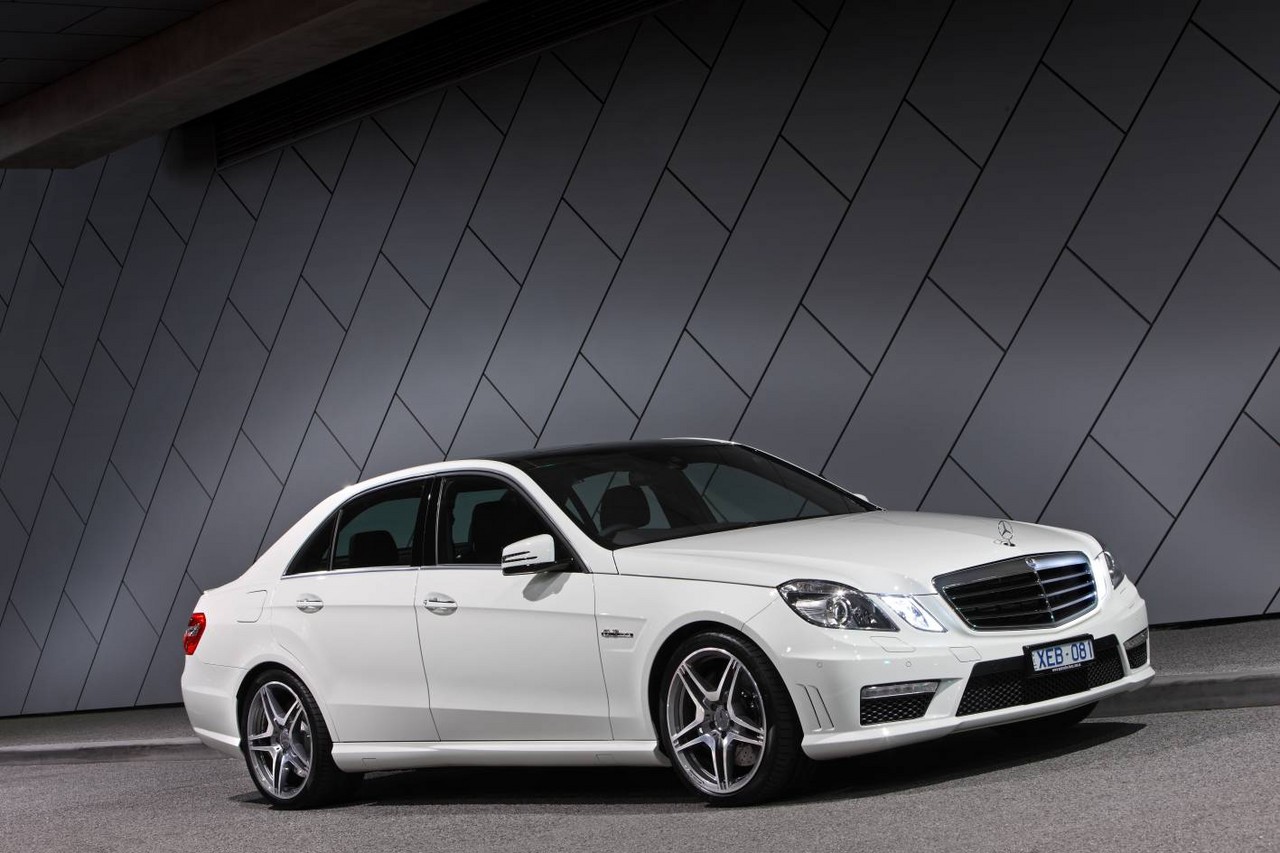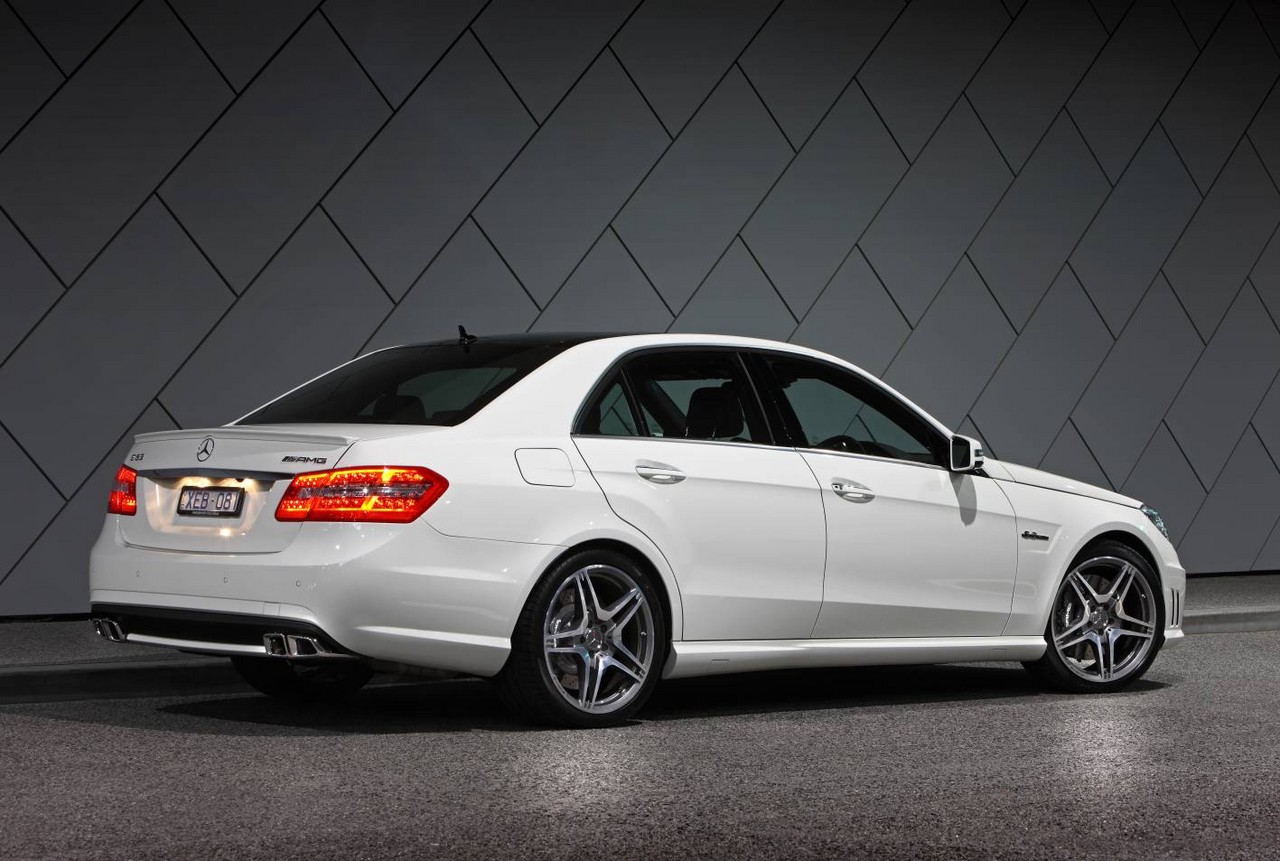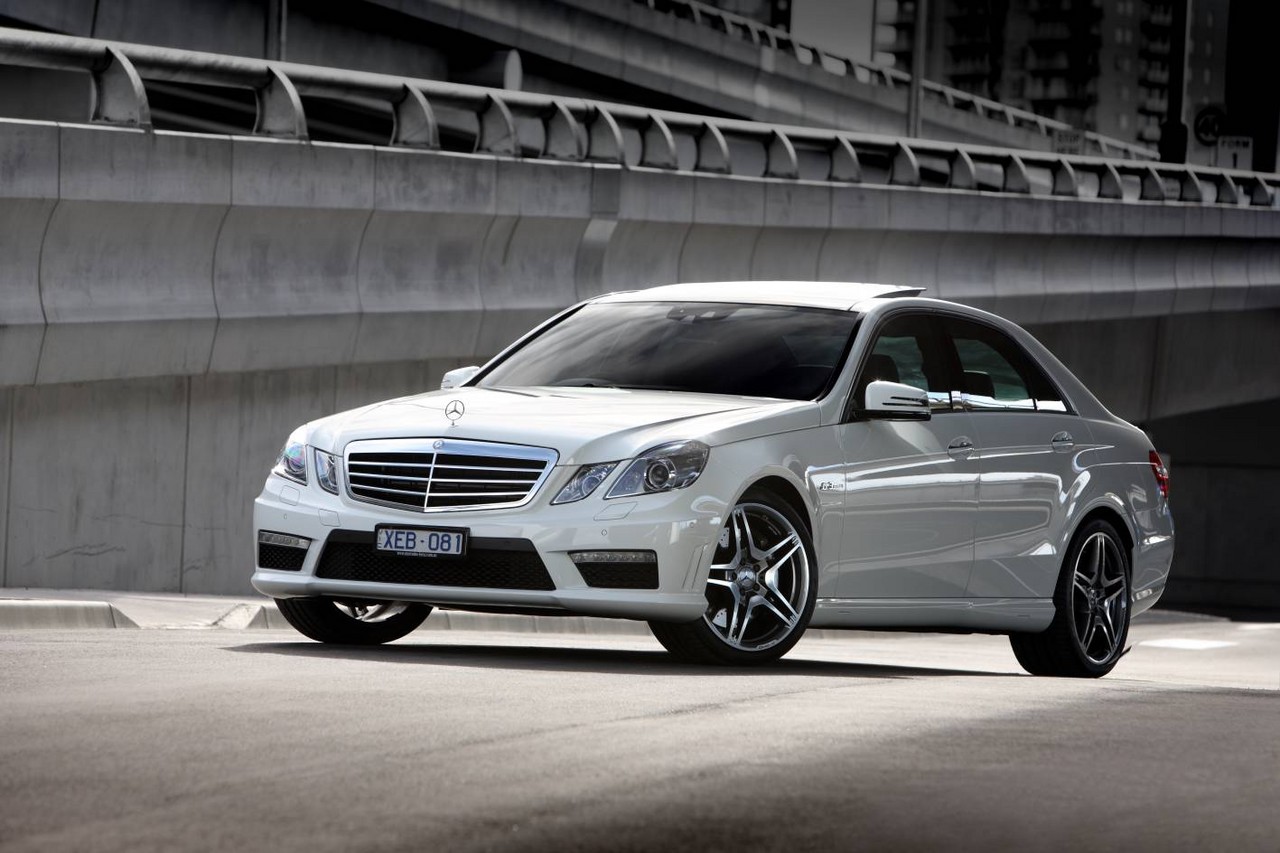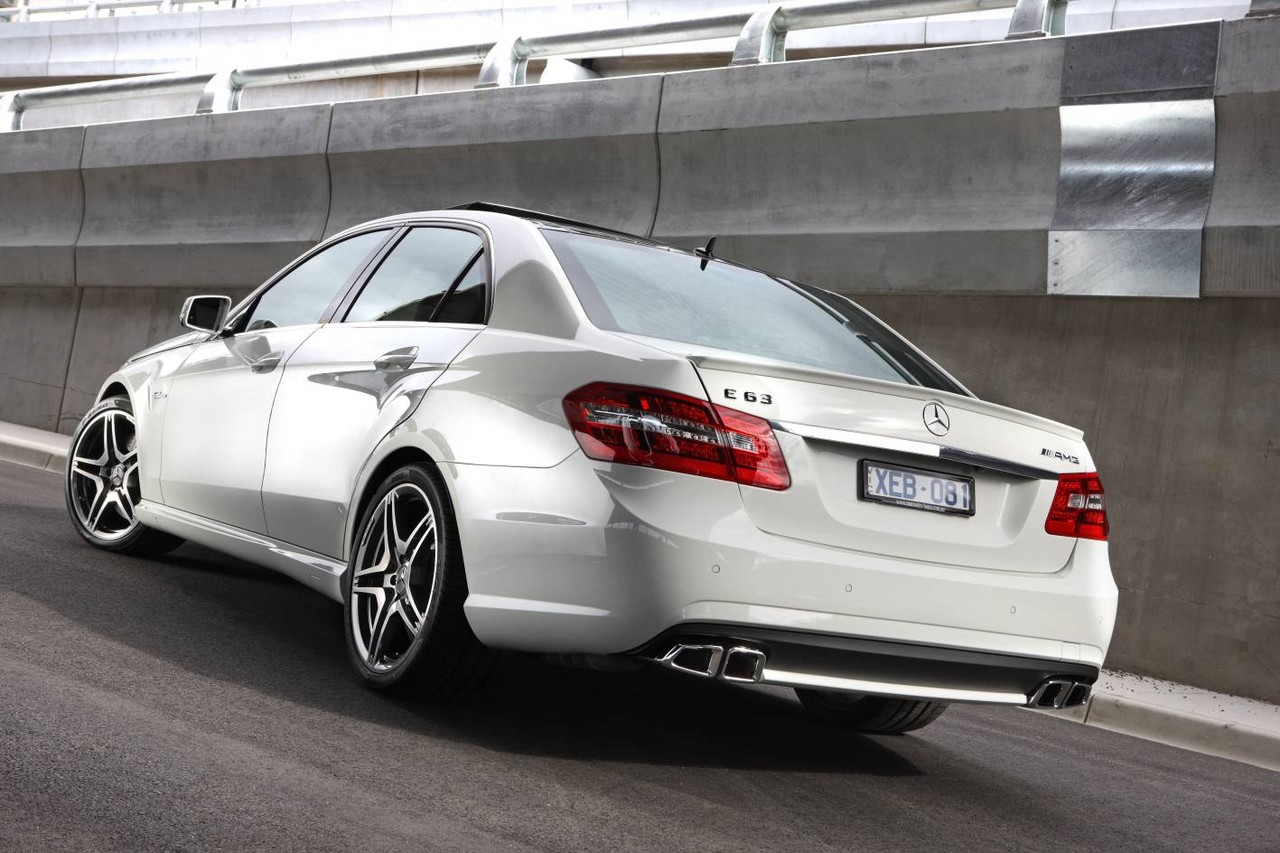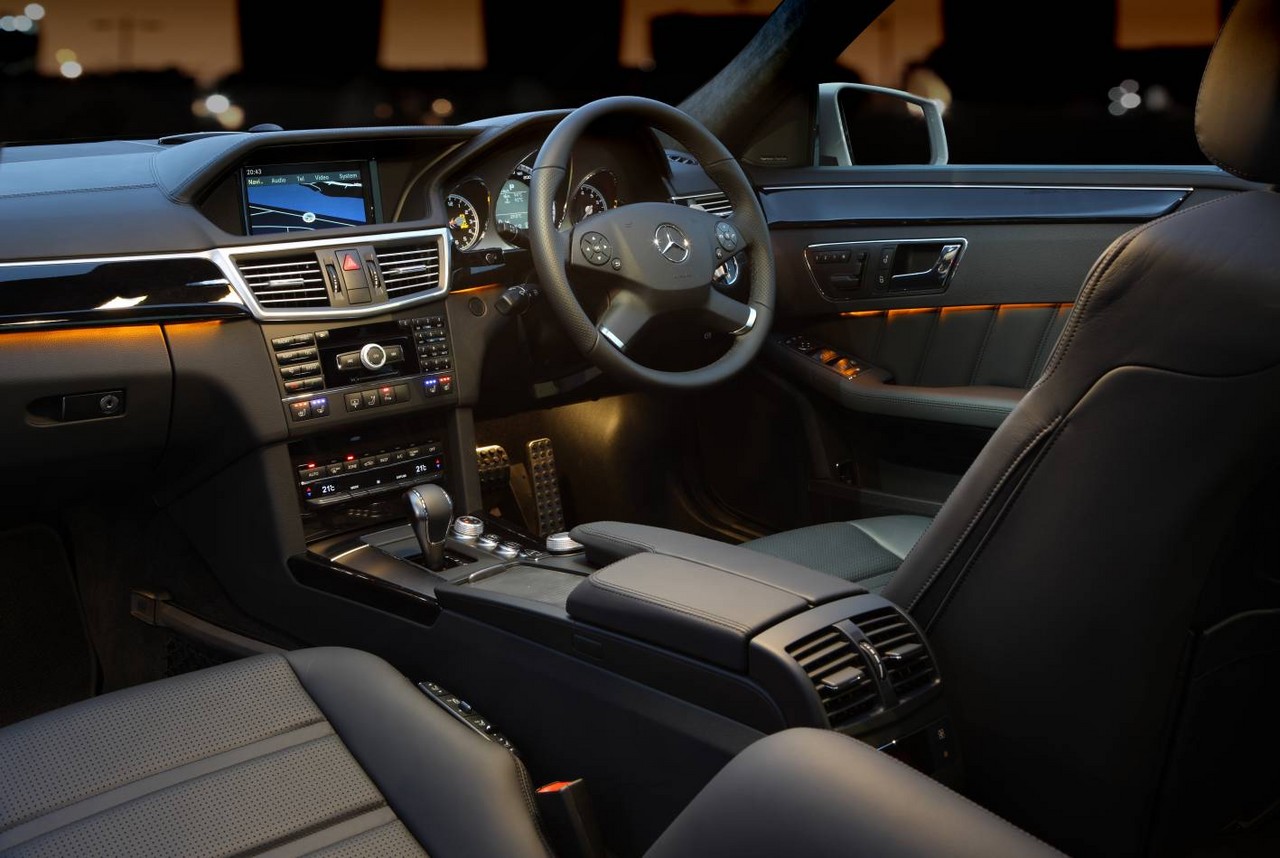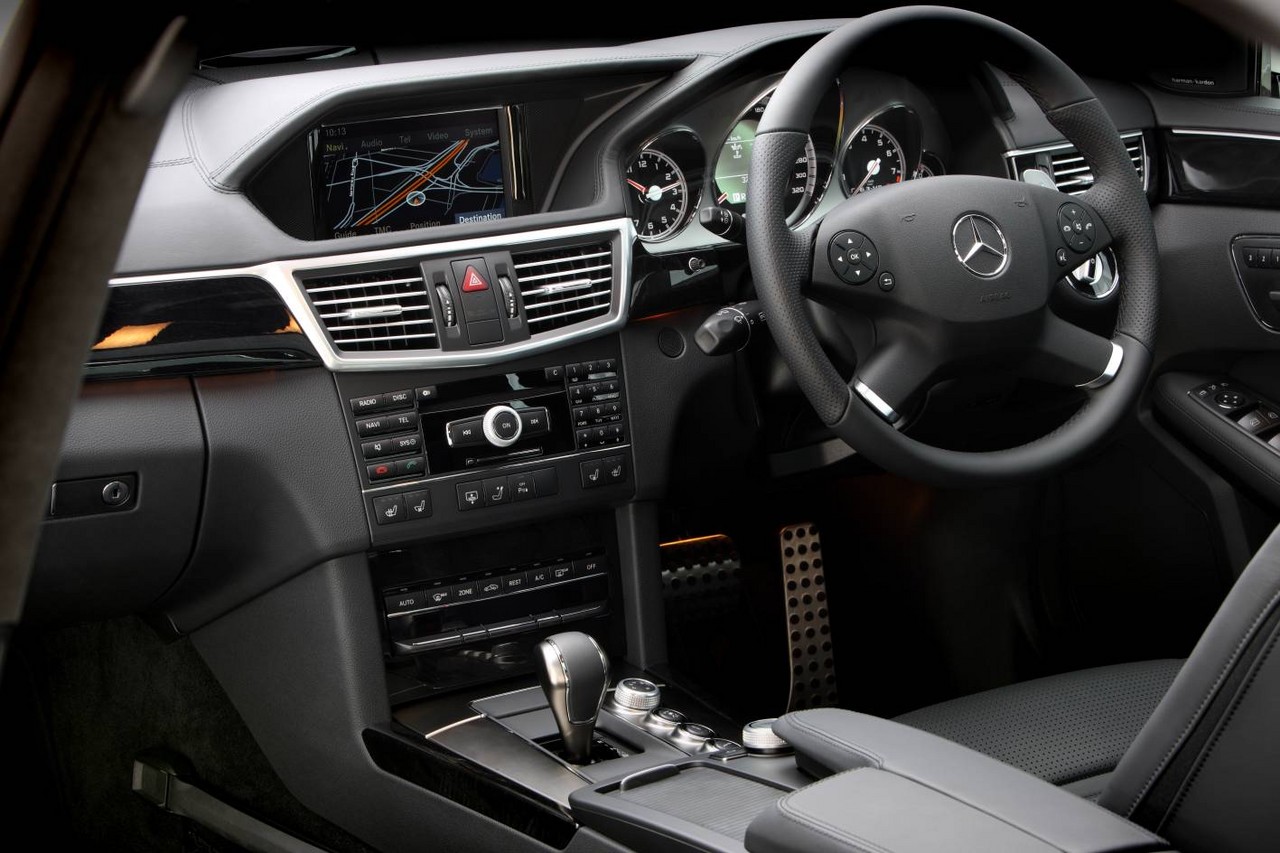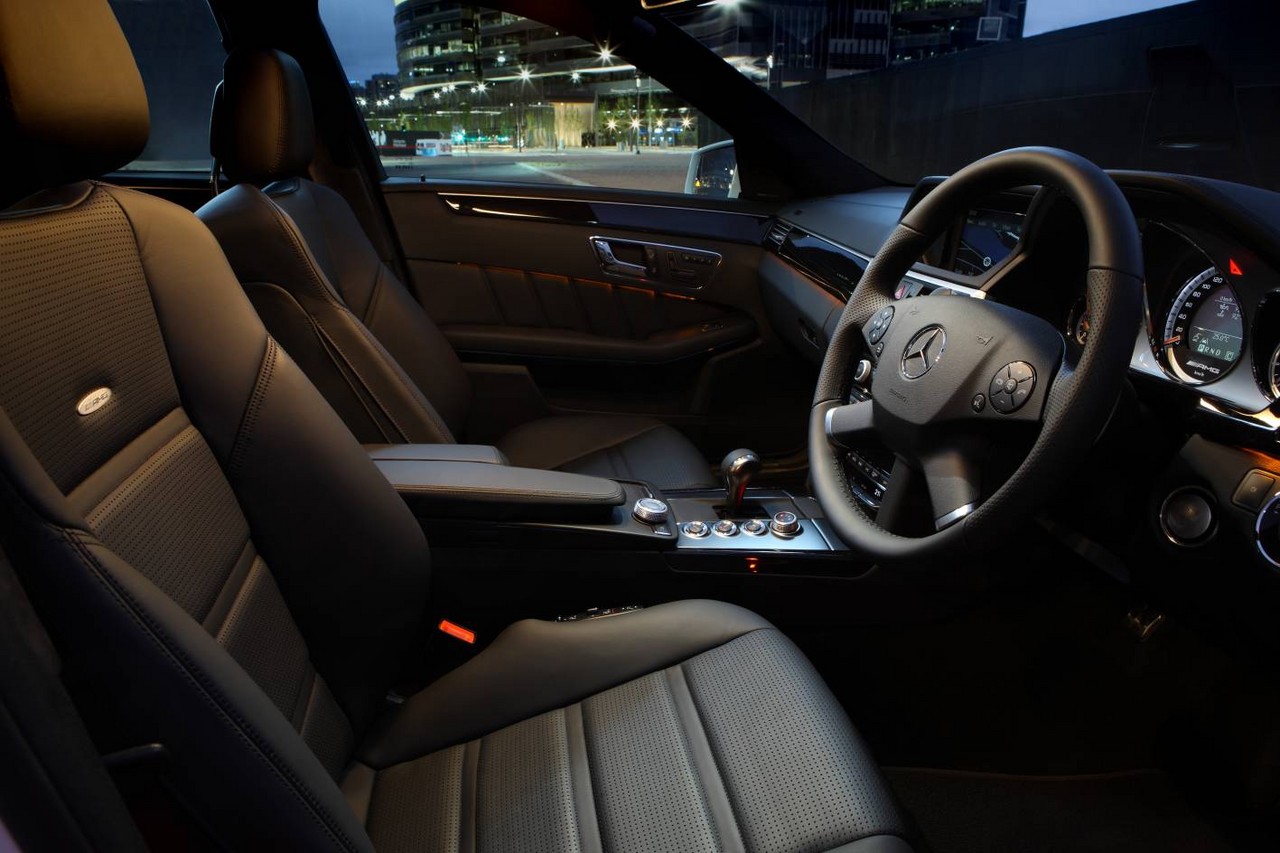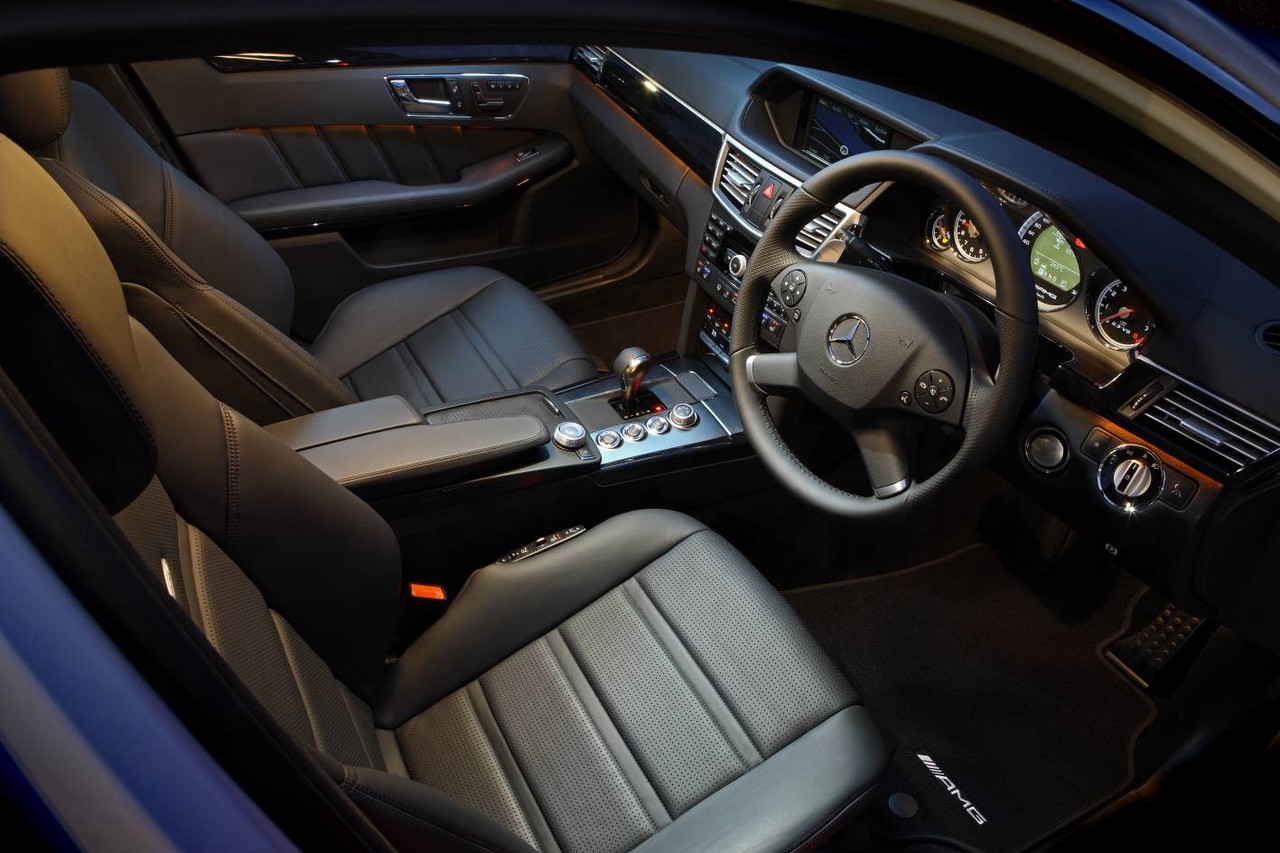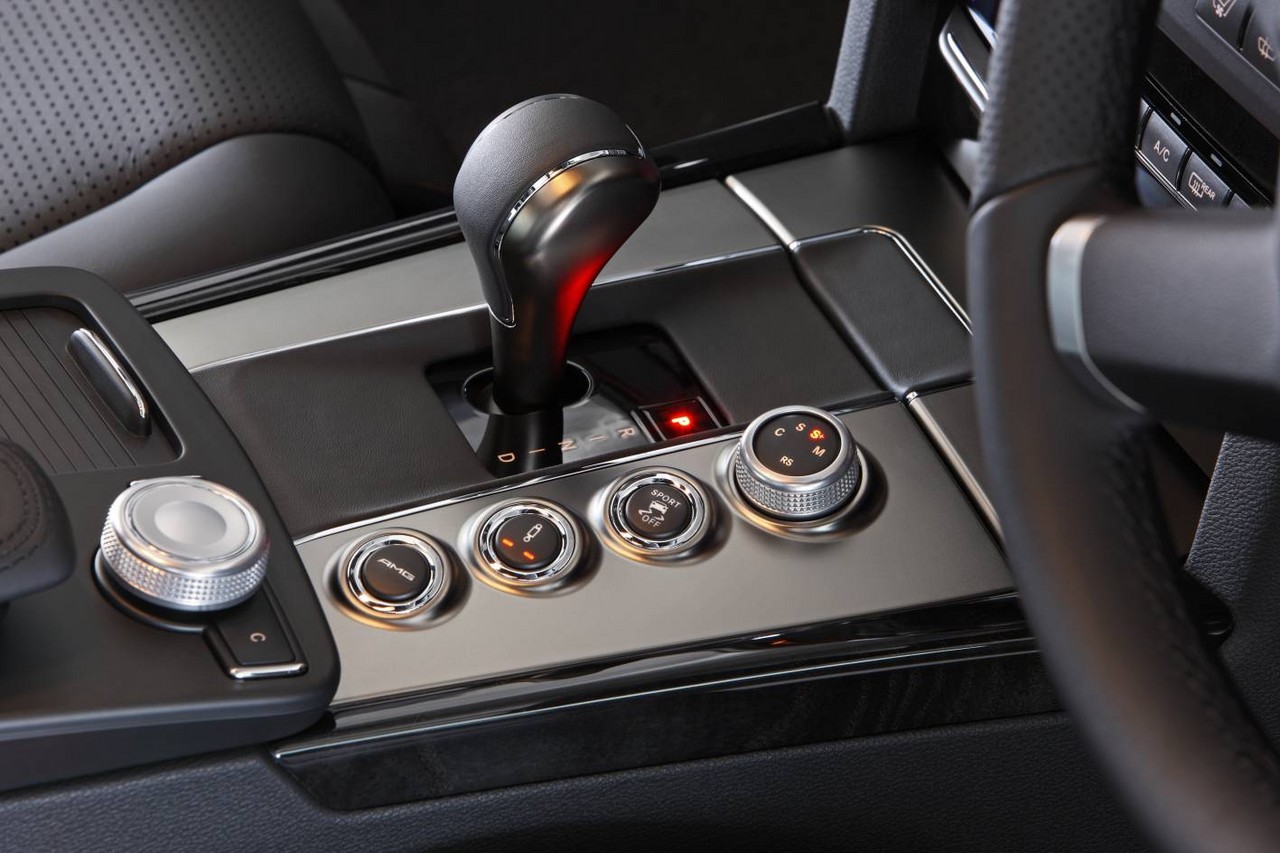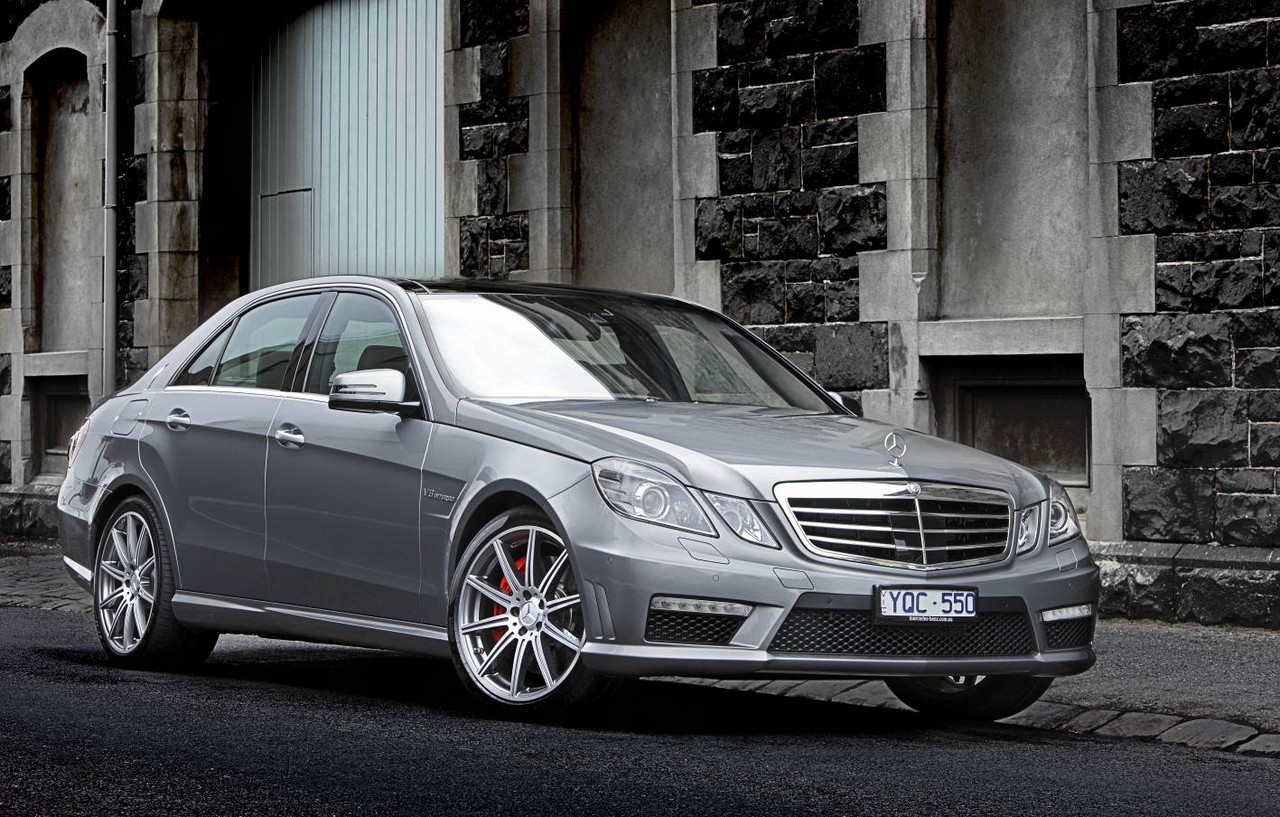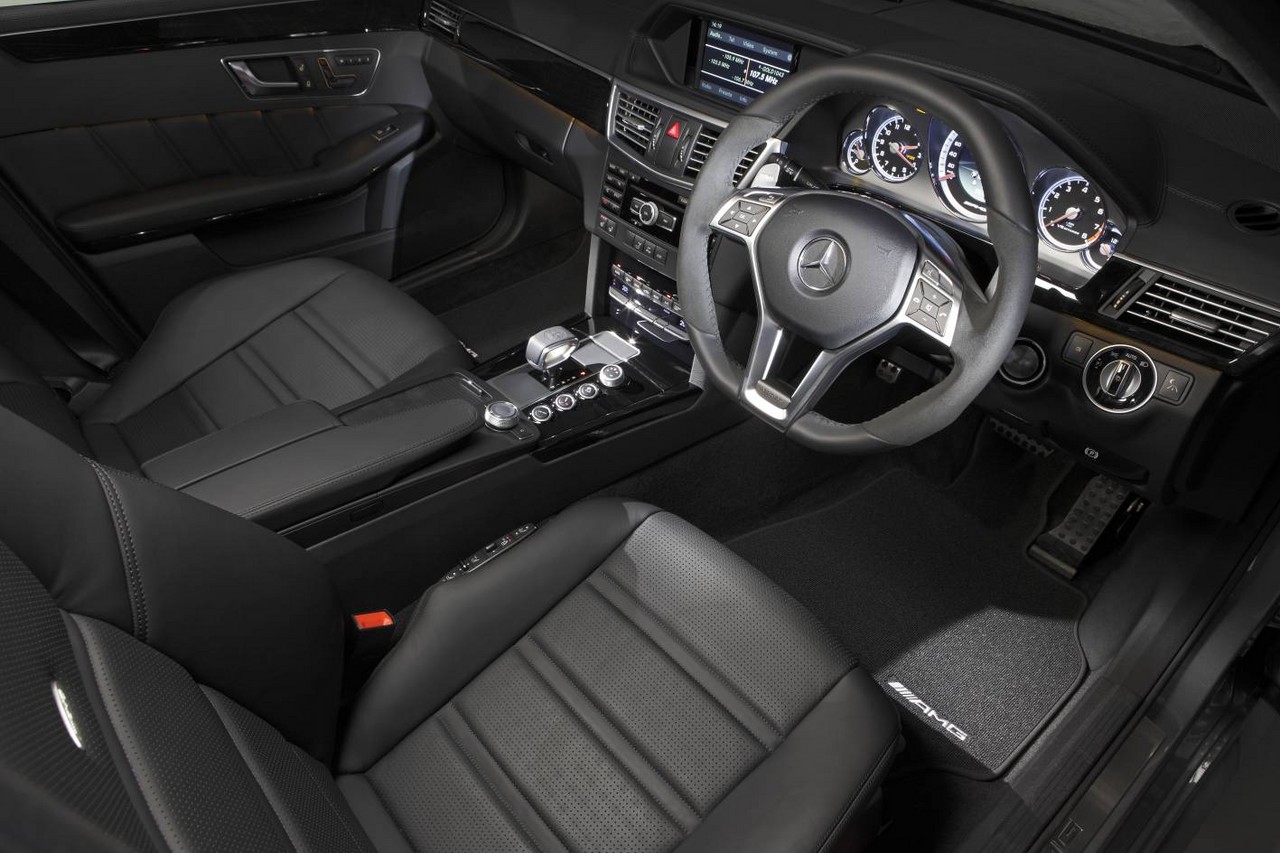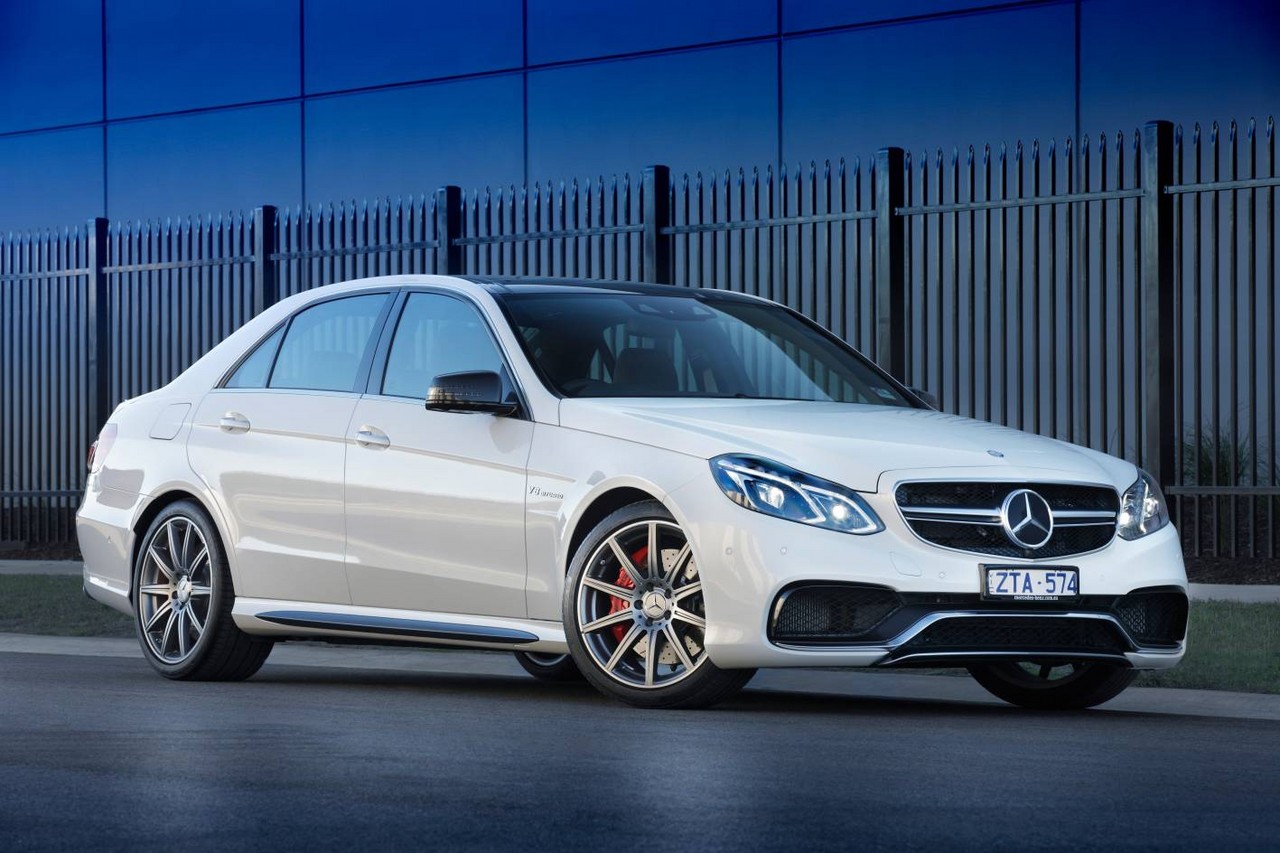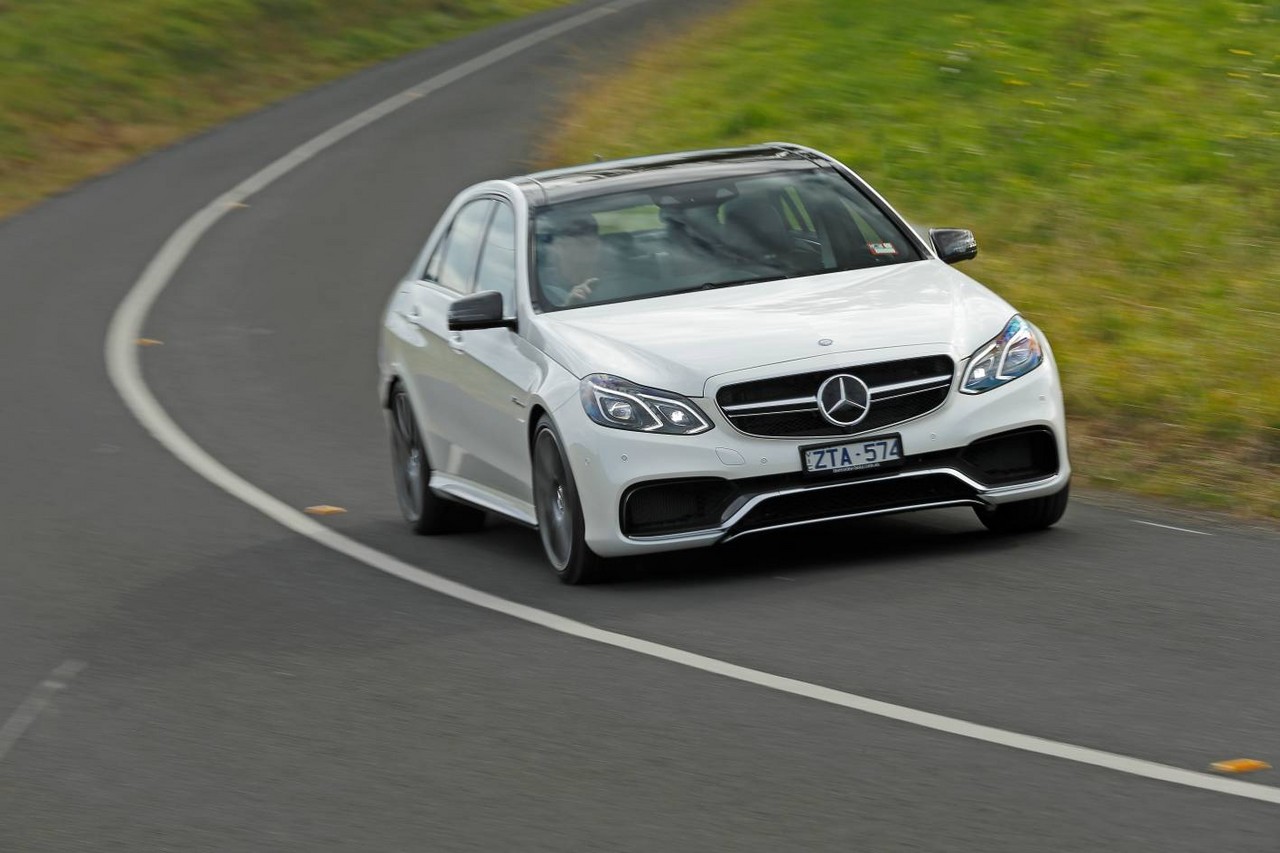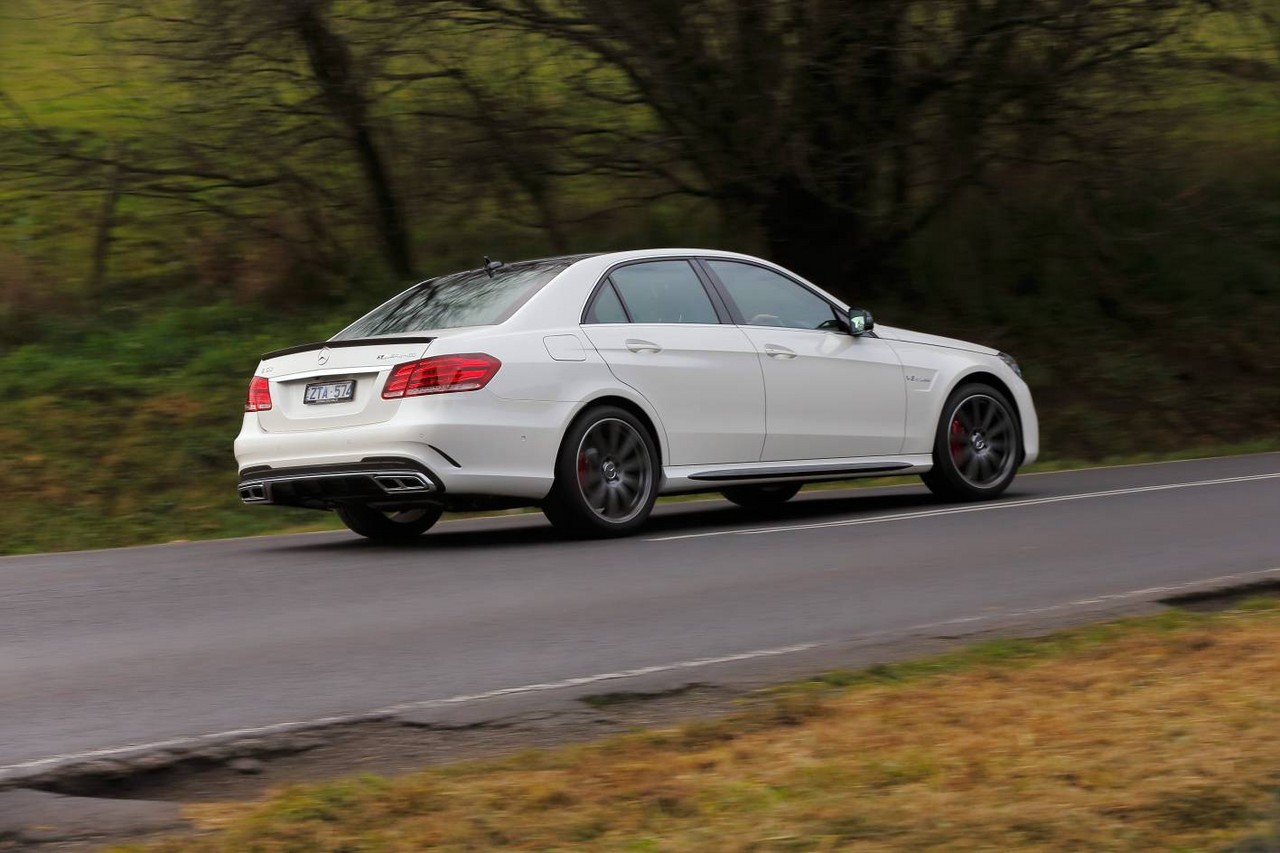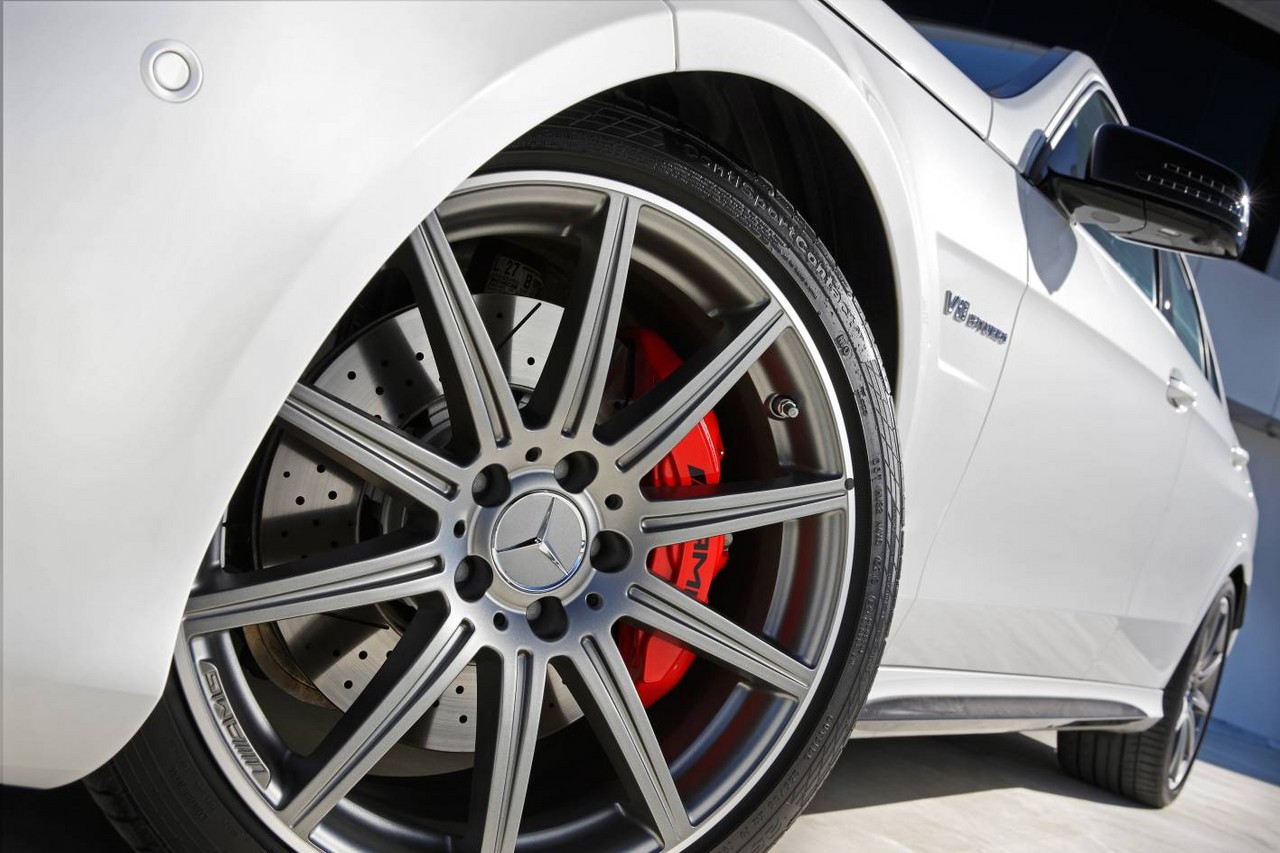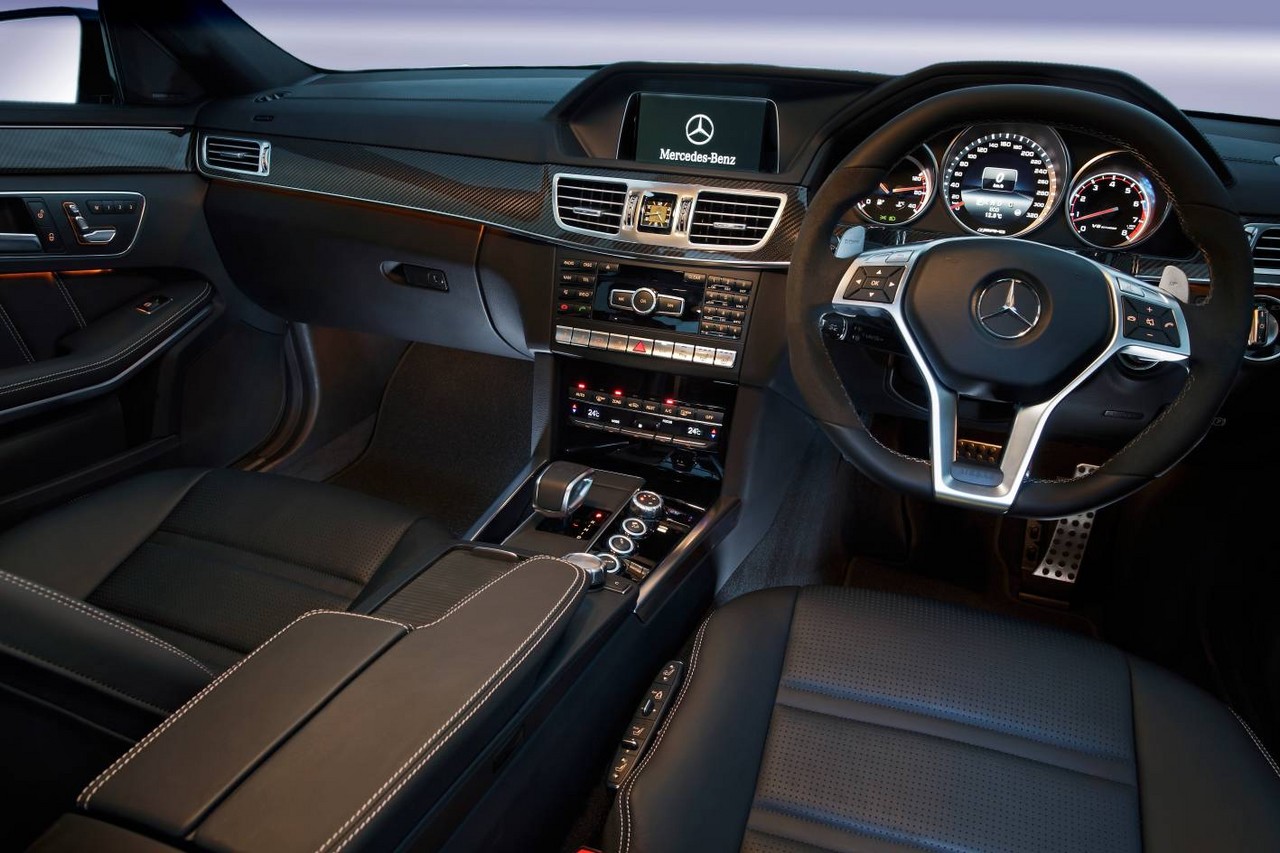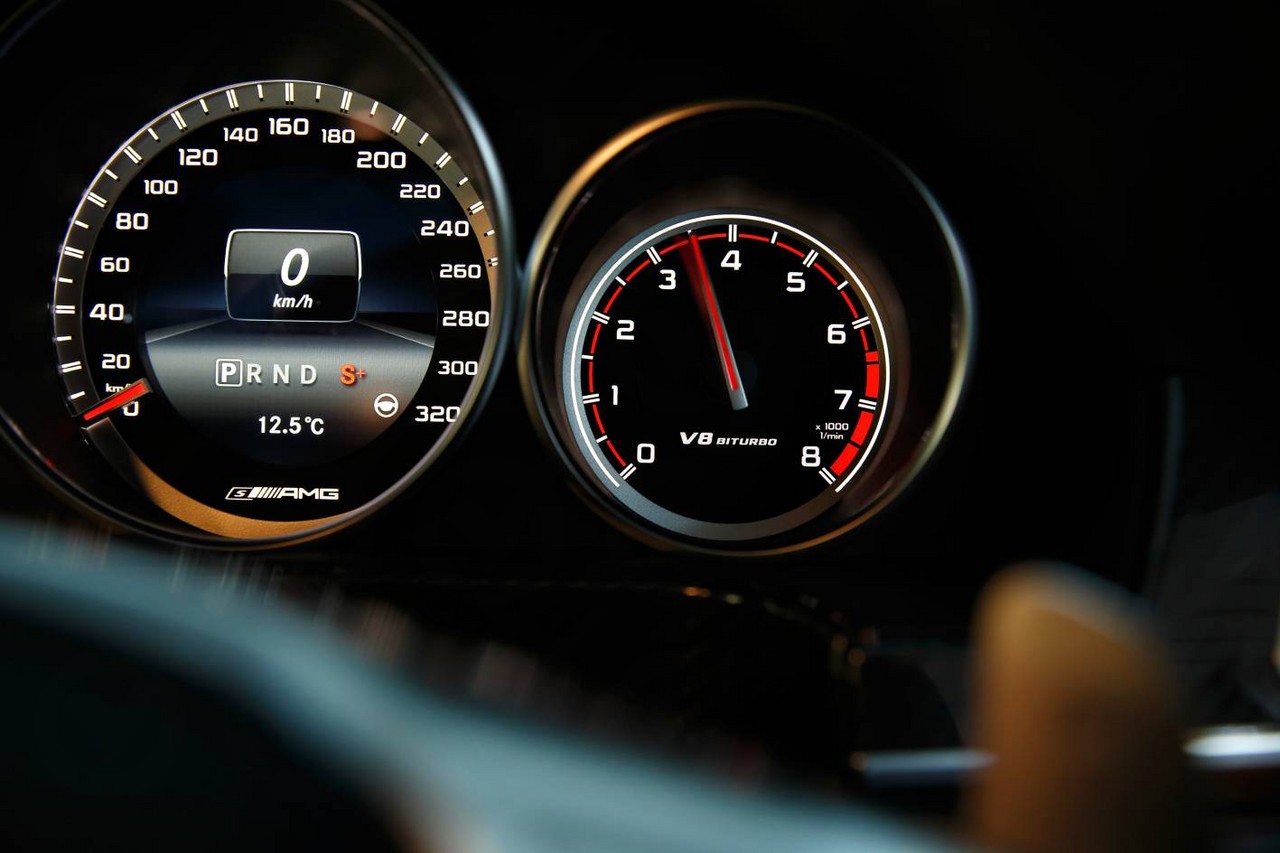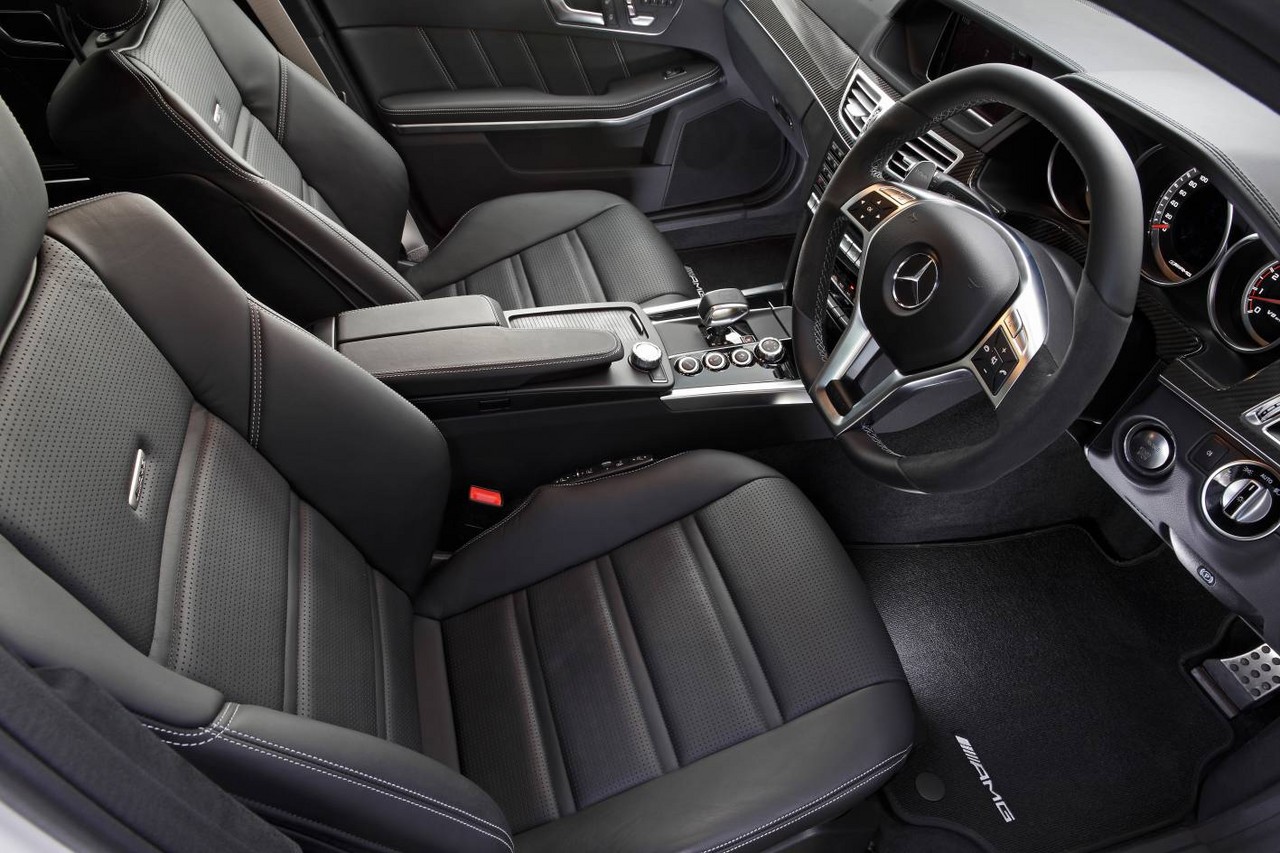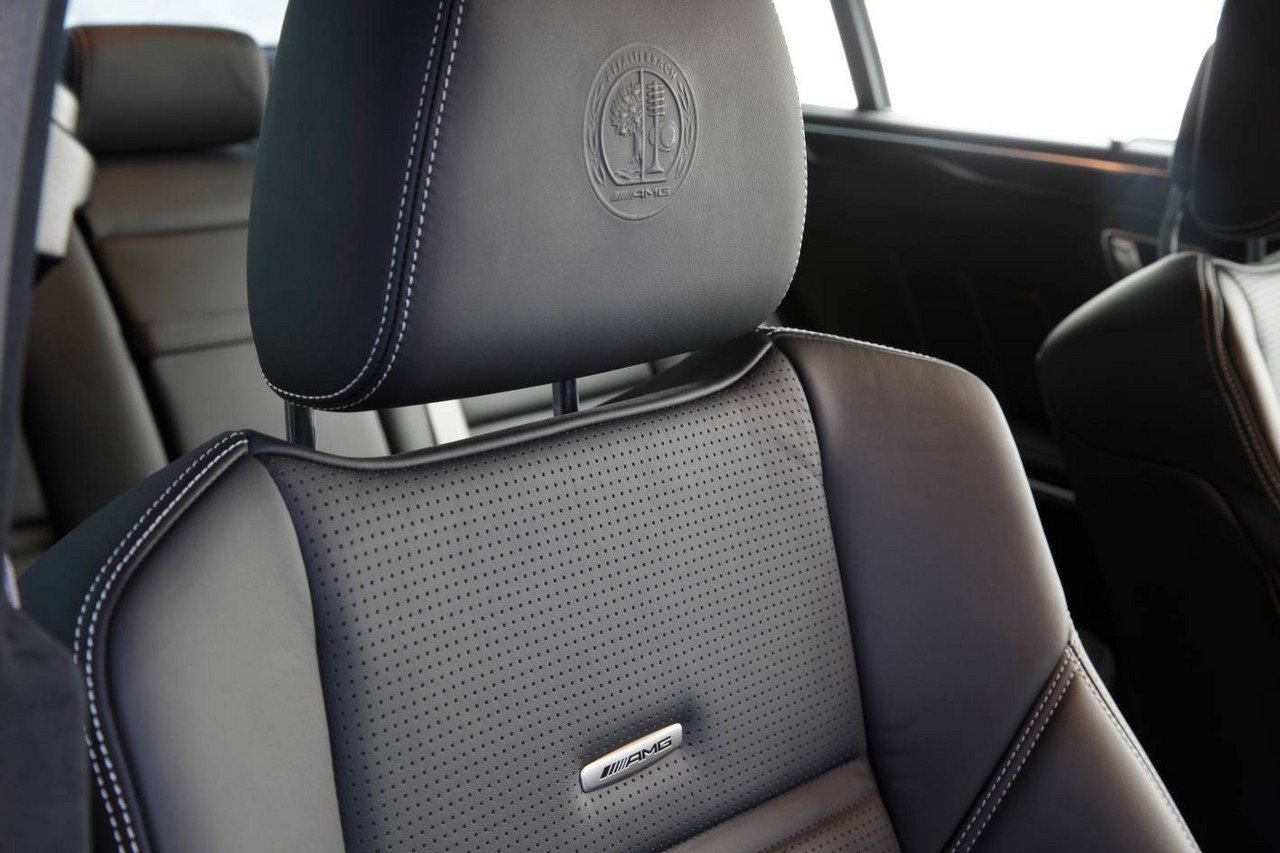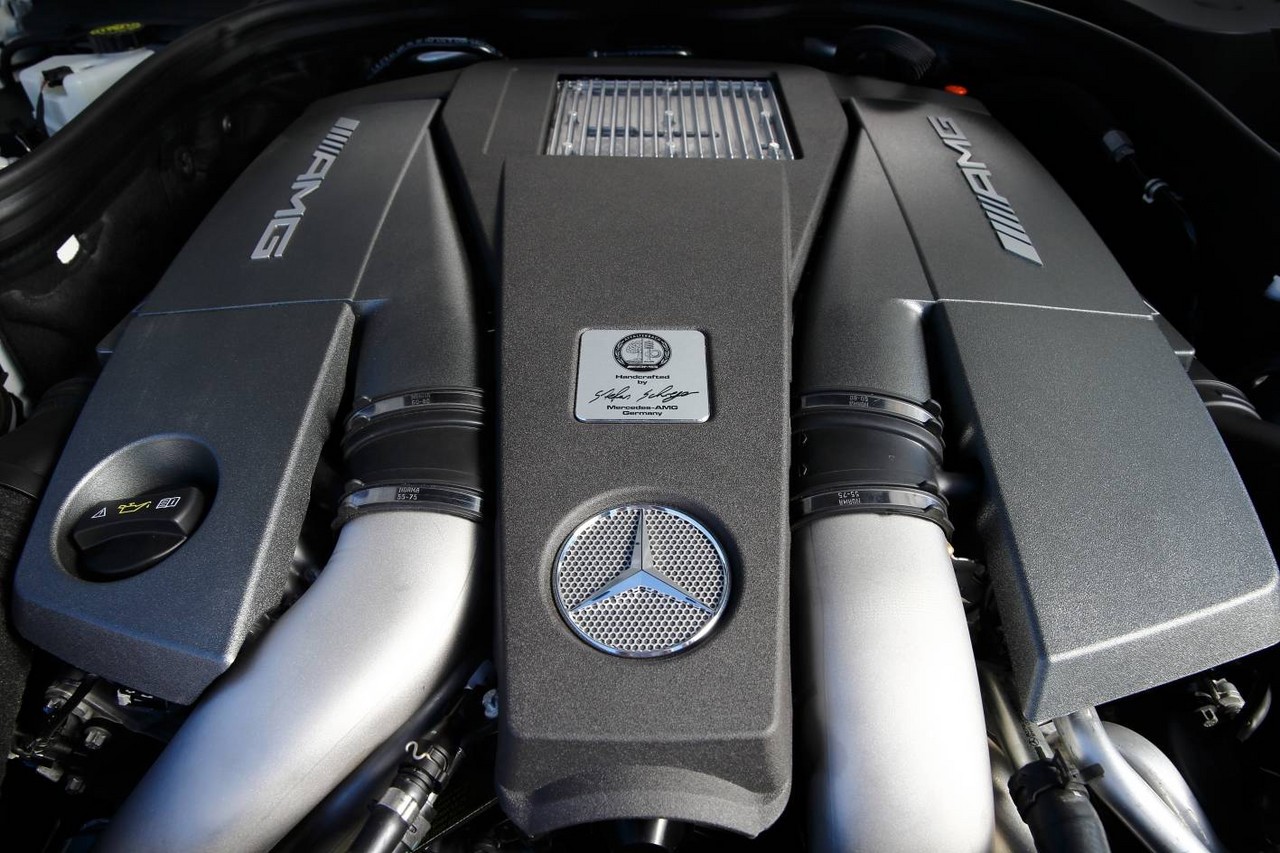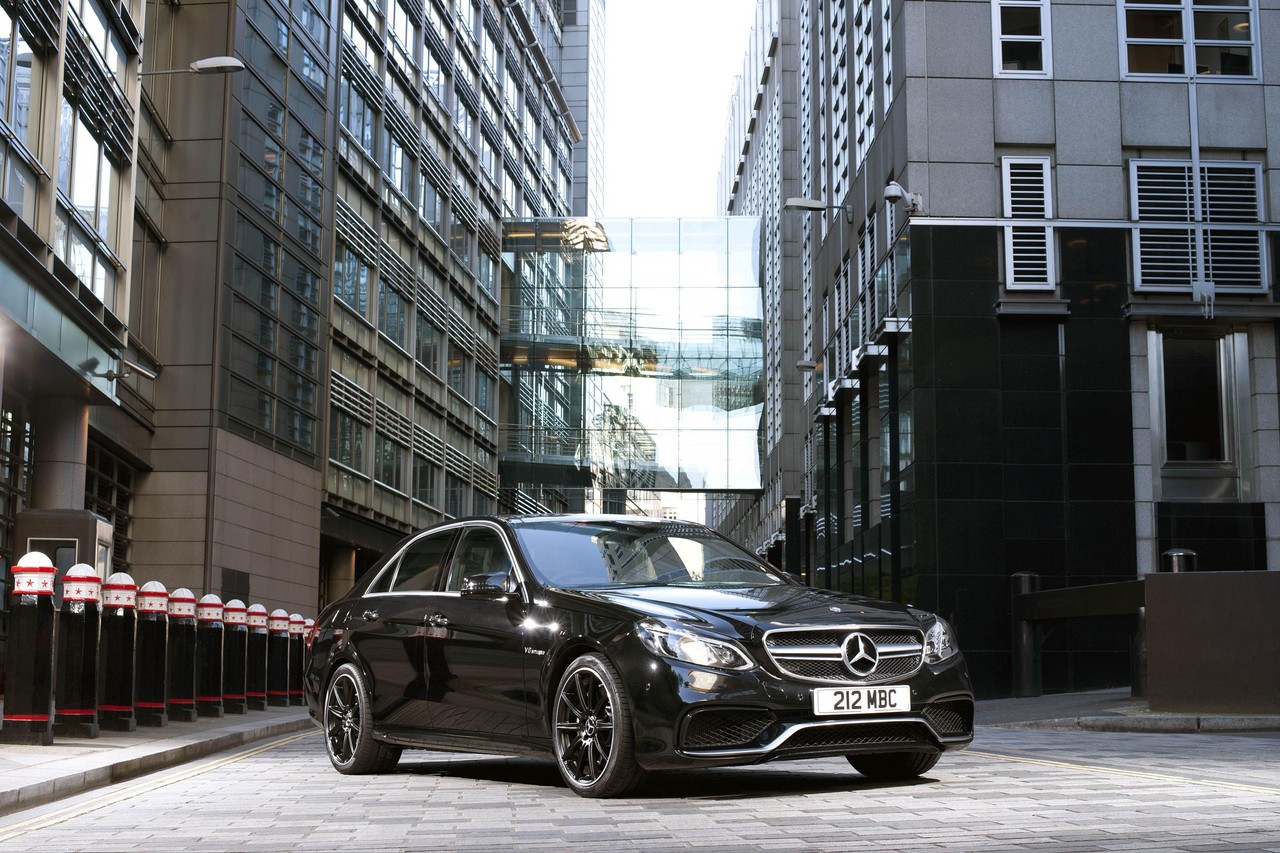
- Eager 6.2-litre M156 V8 engine
- Biturbo 5.5-litre M157 V8 engine gives mid-range punch
- Impressive dynamics
- Body feels solid and rigid
- Light steering is accurate…
- … but lacks feedback and driver engagement
- M156 V8 engine susceptible to cylinder head bolt failure, camshaft lobe and valve lifter wear
- Biturbo engine lacks response and charm of 6.2-litre M156 V8
- Limited slip differential optional for W212.I E 63
Review: Mercedes W212.I E 63 AMG sedan (2009-13)
Overview
Released in Australia in November 2009, the Mercedes-Benz W212 E 63 AMG was a performance, executive sedan. Manufactured in Sindelfingen, Germany, the rear-wheel drive E 63 AMG was initially powered by a naturally aspirated 6.2-litre V8 petrol engine that was mated to a seven-speed semi-automatic transmission.
From April 2011 production – and officially released in Australia in November 2011 – the E 63 AMG was powered by a 5.5-litre twin-turbo V8 petrol engine.
M156 V8 engine
Developed and hand-assembled by Mercedes-AMG in Affalterbach, Germany, the 6208 cc M156 V8 petrol engine had an aluminium-silicon alloy (AlSi7) block which had 102.2 mm bores and a 94.6 mm stroke, an aluminium-silicon alloy (AlSi17) cylinder head, a Cromax 42CrMo4V forged steel alloy crankshaft with six counterweights rotating on five bearins, fracture-split forged connecting rods, cylinder bores with twin-wire-arc-sprayed (TWAS) coating, Bosch 9.7 engine management system, double overhead camshafts per cylinder bank (intake cams driven by a double chain from the crankshaft and small gears on the intake cams drive the exhaust camshafts), continuously variable intake and exhaust camshafts (over a range of 42 degrees via electrohydraulic vane-type adjusters), four valves per cylinder (40 mm intake valves and 34 mm exhaust valves), bucket tappets, a magnesium variable intake manifold (with two electrically-operated internal flaps) and a compression ratio of 11.3:1.
Compared to the M156 V8 engine in the W211 E 63 AMG , changes for the W212 E 63 included:
- An increased range of adjustment for the camshafts (from 40 to 42 degrees);
- A newly designed water cooling system; and,
- On-demand operation of the alternator whereby it had no-load operation during acceleration, but would operate when coasting or braking.
The M156 engine had a maximum engine speed of 7200 rpm and could accelerate from rest to 100 km/h in 4.5 seconds. Over the combined ADR 81/02 cycle, fuel consumption was 12.7 litres per 100 km.
M157 biturbo V8 engine
The M157 V8 engine had an aluminium block with cast-in aluminium-silicon (Silitec) cylinder liners, forged crankshaft made of 38MnS6BY steel alloy (a combination of manganese, sulphur, boron and yttrium) with eight counterweights and rotating in five main bearings, fracture-split forged connecting rods, an aluminium cylinder head, double overhead camshafts (driven by three high-performance chains), variable intake and exhaust camshaft adjustment over a range of 40 degrees via four pivoting actuators, four valves per cylinder and a compression ratio of 10.0:1. Furthermore, the M 157 had a dry weight of 204 kg, maximum engine speed of 6400 rpm and Bosch MED 17.7.3 control unit.
Significantly, the M157 engine had spray-guided direct injection with piezo fuel injectors (operating at 100 to 200 bar on a demand-related basis), a Garrett MGT2260MSL turbocharger for each cylinder bank (welded to the exhaust manifold) and air/water intercooling. For the standard E 63 AMG (386 kW), maximum charge pressure was 1.0 bar; for the E 63 AMG Performance Package (410 kW), however, maximum charge was 1.3 bar. For greater efficiency, the M157 engine had an ‘ECO start/stop system’ – which the driver could disable if desired – and multi-spark ignition whereby the spark plugs could fire multiple times during the combustion sequence for more efficient combustion.
With the M157 V8 engine, the E 63 AMG could accelerate from rest to 100 km/h in 4.3 seconds, or 4.2 seconds with the AMG Performance Package. Over the ADR 81/02 test cycle, fuel consumption was 10.0 litres per 100 km.
| Engine | Years | Trans. | Peak power | Peak torque | |
|---|---|---|---|---|---|
| E 63 AMG | 6.2-litre petrol V8 (M156) |
2009-11 | 7sp semi-auto | 386 kW at 6800 rpm | 630 Nm at 5200 rpm |
| 5.5-litre twin-turbo petrol V8 (M157) | 2011-13 | 7sp semi-auto | 386 kW at 5250-5750 rpm | 700 Nm at 1750-5000 rpm | |
| E 63 AMG Performance edition | 5.5-litre twin-turbo petrol V8 (M157) | 2011-13 | 7sp semi-auto | 410 kW at 5250-5750 rpm | 800 Nm at 2000-4500 rpm |
AMG Speedshift MCT transmission
First introduced in the R230 SL 63 AMG in 2008, the seven-speed ‘AMG Speedshift MCT’ (Multi Clutch Technology) had a compact, wet start-up clutch that operated in an oil bath rather than a conventional torque converter. The AMG Speedshift transmission had four individual driving modes which the driver could select via a rotary dial:
- Controlled Efficiency, ‘C’, for softer throttle response, smooth gearshifts and early upshifts to minimise fuel consumption;
- Sport, ‘S’, for greater throttle response, higher engine speeds before upshifting, greater willingness to downshift and 20 per cent faster gearshifts;
- Sport plus, ‘S+’, for 20 per cent faster gearshifts relative to Sport; and,
- Manual, ‘M’, for maximum throttle response and gearshifts 10 per cent faster than Sport plus (as quickly as 100 milliseconds). For fast gearshifts under full loads, the engine could partially suppress individual cylinders by interrupting ignition and injection.
Other features of the AMG Speedshift transmission included:
- Automatic throttle-blipping on downshifts;
- A double-declutching function for multiple downshifts; and,
- A ‘Race Start’ function.
For the M156 engine, the gear ratios for the ‘AMG Speedshift’ transmission were 4.38 (1st), 2.86 (2nd), 1.92 (3rd), 1.37 (4th), 1.00 (5th), 0.82 (6th) and 0.73 (7th), while the final drive ratio was 3.06. Furthermore, the transmission had a torque capacity of 735 Nm.
For the M157 engine, the forward gear ratios were the same, though the final drive ratio was 2.65 and there were two reverse gears: 3.42 (1st) and 2.23 (2nd).
Dimensions and body
Compared to its W211 E 63 AMG predecessor, the W212 E 63 AMG was 10 mm longer (at 4891 mm), 50 mm wider (1872 mm), 23 mm lower (1442 mm) and had a 20 mm longer wheelbase (2874 mm); kerb weight was unchanged at 1840 kg. Furthermore, the W212 E 63 AMG had boot capacity of 540 litres.
Suspension
The Mercedes-Benz W212 E 63 AMG had three-link front suspension with MacPherson struts and multi-link rear suspension. The suspension featured electronically-controlled dampers (‘AMG Ride Control’) which used sensors to measure drive and brake torque, steering angle, lateral acceleration, ride height, direction of motion and body roll, with the objective of reducing the roll angle of the body. Furthermore, the driver could select from three settings:
- Comfort: for soft damping characteristics;
- Sport: on average, 40 per cent firmer than Comfort; and,
- Sport plus: provided even higher damping resistance.
The rear suspension included air springs that kept the rear of the vehicle at a constant height regardless of load (‘automatic level control’).
Compared to the standard W212 E-Class , changes for the E 63 AMG included:
- A unique steel-sprung front axle with a 56 mm wider track (relative to the W212 E 500 ), new steel spring struts, new control arms, new wheel bearings and new wheel location for additional negative camber; and,
- Rear suspension with a new subframe mounting for greater stability, AMG-specific air springs, and additional negative camber.
Steering
Initially, the E 63 AMG had speed-sensitive rack-and-pinion steering with a ratio of 14.0:1 (22 per cent more direct than W212 E-Class); for greater feedback, the steering column was more rigid and contained a rubber compound Hardy disc between the steering shaft and coupling.
With the introduction of the M157 engine, however, electromechanical speed-sensitive steering was introduced.
Safety equipment
Standard safety equipment for the Mercedes-Benz E 63 AMG included dual front airbags, a driver’s knee airbag, front row pelvis airbags, front and rear side airbags, curtain airbags for the front and second row occupants, ABS, electronic brake force distribution, brake assist, electronic stability control, traction control, active front seat head restraints (‘Neck-Pro’) and front and outer rear seatbelts with pre-tensioners and load limiters. Furthermore, the electronic stability control system had a ‘sport’ mode which had higher thresholds for intervention and could also be deactivated.
Additional safety technologies – fitted as standard – for the E 63 AMG included:
- Mercedes-Benz’s ‘Pre-Safe’ which anticipated and prepared for collisions by tensioning the seatbelts, adjusting the seat positions for optimal airbag deployment and closing the sunroof (if open);
- Lane departure warning (‘Lane Keeping Assist’);
- Blind spot monitoring (‘Blind Spot Assist’); and,
- Driver fatigue monitoring (‘Attention Assist’).
The E 63 AMG was also fitted with an ‘active’ bonnet which would automatically rise in the event of a collision to cushion a pedestrian’s impact.
Brakes
The Mercedes-Benz E 63 AMG had 360 mm by 36 mm ventilated and perforated front brake discs with six-piston callipers and 360 mm by 26 mm ventilated and perforated rear discs with four-piston callipers.
Available as an extra-cost option, the AMG ceramic composite brakes were manufactured from carbon-fibre-reinforced ceramic in a vacuum at 1700 degrees Celsius. The front ceramic brake discs were 402 mm by 39 mm at the front and 360 mm by 32 mm at the rear.
Euro NCAP testing
In Euro NCAP testing , a 2010 Mercedes-Benz W212 E 220 CDI sedan received a five star safety rating which included an 86 per cent adult occupant protection rating and a 77 per child occupant protection rating. In the frontal offset impact test, there was a slight risk of serious chest and leg injury for the front occupants; maximum points were awarded in the side and pole impact tests. Under ANCAP’s methodology , this testing resulted in an adult occupant protection rating of 34.88 out of 37.
Features: 2009 Mercedes-Benz E 63 AMG (M156)
Standard features for the Mercedes-Benz E 63 AMG included 19-inch forged AMG alloy wheels, 9.0J x 19-inch front wheels with 255/35 R19 tyres and 9.5J x 19-inch rear wheels with 285/30 R19 tyres, a fifteen speaker Harman Kardon Logic7 surround sound system, six-disc CD player, auxiliary inputs (3.5mm/USB/iPod) and MP3/WMA/AAC compatibility, Mercedes-Benz’s COMAND APS (Cockpit Management and Data Auto Pilot System) with a seven-inch colour display, HDD satellite navigation, CD/DVD player, 6GB HDD music register, TV tuner (analogue and digital), Bluetooth connectivity and voice recognition (‘Linguatronic’), three-zone climate control air conditioning (‘Thermotronic’), AMG front sports seats with active bolsters, Nappa leather upholstery, multi-contour front seats with power adjustment, cruise control with variable limiter (‘Speedtronic’), directional bi-xenon headlights, LED daytime running lights, rear fog lights, rain-sensing wipers, automatic headlights, a reversing camera, rear parking sensors with park guidance display (‘Parktronic’), 1/3 to 2/3 split and folding rear seats, an AMG sports steering wheel with gearshift paddles, remote central locking, power windows and heated mirrors, a power adjustable steering column (for height), front seat memory settings, push-button start (‘keyless go’), automatically dimming rear view and door mirrors, Alcantara roof lining and interior trim, a power-operated panoramic glass sunroof, ambient lighting, 12 volt power outlet, tinted windows, a power-operated rear blind and manual rear door blinds, velour floor mats, AMG instrument cluster including ‘Racetimer’, a trip computer, a motion-sensing alarm and an immobiliser.
Upon its launch, extra-cost options for the E 63 AMG included:
- A rear axle differential with a 40 per cent locking action;
- AMG Exterior Carbon package;
- A three-spoke AMG Performance steering wheel; and,
- AMG carbon-fibre interior trim.
Features: 2011 Mercedes-Benz E 63 AMG (M157)
For Mercedes-Benz E 63 AMG models powered by the 5.5-litre twin-turbo V8 engine, the E63 AMG featured a full-colour TFT display within the speedometer (as per the C218 CLS 63 AMG ) and a three-spoke ‘AMG Performance’ steering wheel with a flattened top and bottom.
Visually, the M157 E 63 AMG models could be identified by their new 19-inch AMG alloy wheels. For the E 63 AMG Performance Pack, distinguishing features included black Alcantara in the grip areas of the steering wheel, red-painted brake callipers and a carbon fibre AMG spoiler lip.
Brochure
Related links
- Press Kit: Mercedes-Benz W212.I E-Class (March 2009)
- Press Kit: Mercedes-Benz W212.I E-Class – new engines (May 2011)
- Press Kit: Mercedes-Benz W212.I E 63 AMG (July 2009)
- Press Kit: Mercedes-Benz W212.I E 63 AMG (July 2011)
Review: Mercedes W212.II E 63 AMG S sedan (2013-16)
Overview
Released in Australia in September 2013, the Mercedes-Benz W212 Series II (W212.II) E-Class AMG range was reduced to a single variant: the E 63 AMG S. The W212.II E 63 AMG S introduced updated styling, an upgraded interior and a range of ‘intelligent drive’ technologies which would be shared with the W222 S-Class.
Visually, the W212.II E 63 AMG S could be identified by its new headlights with partial LED lights and a single headlamp lens (full LED headlights were available as an option), redesigned bonnet, new bumpers, ‘twin blade’ radiator grille, side air intakes with black flics and new tail-lights with horizontally structured LEDs.
Inside, the dashboard had full-width two-part trim and could be specified in a wood or aluminium look, while new elements included a three-tube instrument cluster, a trapezoidal framed display in the head unit and an analogue clock between the two central air vents. The centre console was also redesigned and, for automatic models, omitted a gear lever as the multifunction steering wheel had a ‘Direct Select’ lever and gearshift paddles.
M157 engine: 430 kW and 800 Nm
For the W212.II E 63 AMG, peak power and torque for the M157 engine increased to 430 kW and 800 Nm, respectively. According to Mercedes-Benz , ‘[t]he technical basis for this uprating results from adaptation of the engine application, an increase in peak pressure and a rise in the charge pressure from 0.9 to 1.0 bar.’ This statement, however, is in conflict with Mercedes-Benz’s announcement when the M157 engine was first introduced that charge pressure was 1.0 and 1.3 bar for the standard and Performance Package engines, respectively.
| Engine | Trans. | Peak power | Peak torque | |
|---|---|---|---|---|
| E 63 AMG S | 5.5-litre twin-turbo petrol V8 (M157) | 7sp semi-auto | 430 kW at 5500 rpm | 800 Nm at 1750-5000 rpm |
Safety equipment
Compared to its W212.I predecessor, standard safety equipment for the Mercedes-Benz W212.II E 63 AMG S was extended to include ‘Collision Prevention Assist’, a radar-based system which provided the driver with visual and acoustic warnings if the distance from the vehicle ahead rapidly closed. As part of the system, the braking system was also primed to provide additional braking assistance.
The E 63 AMG S was also equipped with Mercedes-Benz’s ‘intelligent drive’ assistance systems which utilised a ‘Stereo Multi-Purpose Camera’ positioned in front of the rear-view mirror. The stereo camera had two lenses set at an angle of 45 degrees and with an overall range of 500 metres, providing a three-dimensional view of the area up to 50 metres ahead of the vehicle. For these models, the standard-fit ‘Driving Assistance Package Plus’ included:
- Distronic Plus with Steering Assist: an ‘adaptive’ cruise control system which used two short-range radar sensors positioned behind the front bumper to monitor the road up to 30 metres ahead, and a long-range radar located behind the radiator grille which had a range of 200 metres. Operating at speeds up to 200 km/h, Distronic Plus used an electronic control unit to analyse the information from both radar systems to calculate the engine, automatic transmission and braking parameters required for proximity control. As such, Distronic Plus could automatically apply the brakes to prevent the vehicle from becoming too close to traffic ahead (the time interval could be specified) and accelerate back to the set speed when traffic allowed. To accelerate from rest, the driver only needed to operate the Distronic stalk on the steering column or briefly depress the accelerator pedal. With Distronic Plus, automatic deceleration of up to four (4) m/s2was possible. If Distronic Plus detected that heavier braking was required, a warning light would illuminate in the instrument cluster and be accompanied by an audible warning. Furthermore, the electronic proximity control system could be activated independently of Distronic Plus at speeds over 30 km/h to alert the driver if they were approaching another vehicle too rapidly. Furthermore, a Steering Assist function could provide steering torque when travelling on straight roads and gentle bends to make it easier to keep the vehicle in its lane;
- Pre-Safe Brake: Pre-Safe Brake (autonomous emergency braking): using two 24 GHz sensors behind the front bumper which had a range of 30 metres and a 77 GHz radar which had a range of 150 metres, Pre-Safe Brake operated at speeds between 30 km/h and 180 km/h, and at speeds below 70 km/h if the vehicle was approaching a stationary queue of traffic. Around 2.6 seconds before the anticipated moment of impact, an audible warning would sound and a red warning would appear in the tachometer. Around 1.6 before the calculated impact, the first stage of Pre-Safe Brake would initiate partial braking autonomously with around 40 per cent of the maximum braking power (approximately four (4) m/s2); the Pre-Safe occupant protections system would also be activated. If the driver then applied the brakes, maximum braking force would be made available. If the driver failed to react, Pre-Safe Brake would – in its second stage – initiate autonomous emergency braking (i.e. maximum braking power) around 0.6 seconds before the unavoidable collision to reduce the severity of the impact. At initial speeds of 50 km/h, rear-end collisions could be avoided;
- Pre-Safe Plus: could anticipate an imminent rear-end collision and warn the vehicle behind by flashing the tail-lights. The Pre-Safe system would then deploy occupant protection measures and apply the vehicle’s brakes to prevent secondary accidents;
- BAS PLUS with Junction Assist: used a 24 GHz radar sensor with a range of 30 metres and a 77 GHz radar sensor with a range of 150 metres to monitor the distance to the vehicle ahead and would warn the driver if there was a risk of a collision. Brake Assist Plus could detect vehicles when travelling at speeds up to 200 km/h, and stationary objects when the driver was travelling at 7 km/h to 72 km/h. Significantly, Brake Assist Plus could calculate the necessary brake force assistance to prevent a rear-end collision, build up that pressure in the braking system and provide it as soon as the brake pedal was depressed for ‘the best possible deceleration’. Furthermore, the Junction Assist function increased braking assistance when traffic and pedestrians were detected to be crossing in front of the vehicle;
- Active Lane Keeping Assist: could detect when the adjacent lane was occupied (including oncoming traffic) and prevent the driver from inadvertently exiting from the lane when it was not safe to do so by applying a corrective braking force to the wheels on one side of the vehicle; and,
- Active Blind Spot Assistance: active at speeds above 60 km/h, a corrective braking force would be applied to the wheels on one side of the vehicle if the driver attempted to change lanes when a vehicle was detected in the driver’s blind spot.
Features: Mercedes-Benz E 63 AMG S
Compared to its W212.I predecessor, standard features for the W212.II E 63 AMG S were extended to include a digital radio (DAB+) tuner, SD card input, Internet connectivity, LED headlights (which replaced the bi-xenon headlights), a 360-degree camera which could provide a virtual bird’s eye view of the vehicle, black designo headlining, IWC-design analogue clock and tyre pressure monitoring; the analogue TV tuner omitted.
The E 63 AMG S was also fitted with a rear differential lock fitted as standard.
Brochures
- Brochure: Mercedes-Benz W212.II E-Class Sedan and S212.II E-Class Estate (April 2013)
- Brochure: Mercedes-Benz W212.II E-Class Sedan and S212.II E-Class Estate (October 2013)
Related links
- Press Kit: Mercedes-Benz W212.II E-Class (February 2013)
- Press Kit: Mercedes-Benz W212.II E 63 AMG (February 2013)
- Specifications: Mercedes-Benz W212.II E-Class Sedan (March 2014)
- Specifications: Mercedes-Benz W212.II E-Class Sedan (September 2014)
- Wikipedia.org: Mercedes-Benz W212 E-Class
